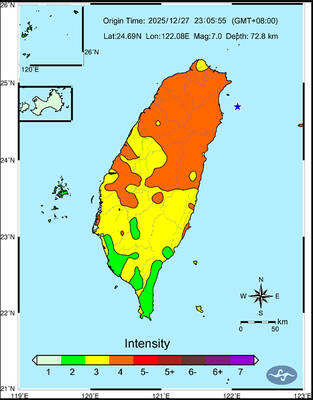China's military is changing its strategy from deterrence to pre-emption, planning to use "paralysis warfare" against Taiwan in the future, the Ministry of National Defense said in a report delivered to the legislature's defense committee yesterday.
"Paralysis warfare features Web-based information warfare, saturation ballistic missile attacks, joint precision strikes and seizure of the enemy's capital city by special operations units," the report says.
"Such tactics will become a major option for the Chinese military in its choice of modes of attack against Taiwan in the future," it says. "They emphasize shock and awe effects against the enemy."
The report, which was delivered to lawmakers on the defense committee yesterday, singles out paralysis warfare as the most likely mode of attack that China would use against Taiwan.
Minister of National Defense Tang Yao-ming (
The report says the number of short-range ballistic missiles that China has in its inventory has reached 500. It does not state that these missiles are aimed at Taiwan, but it is believed that Taiwan would be the target.
The report also confirms that China has established a second airborne corps to increase its troops ready for use against Taiwan.
The new airborne corps has been the subject of media speculation in recent months, but had not been confirmed by the ministry until now.
The ministry believes China's military is seeking to acquire the ability of rapid and long-distance deployment of forces.
To counter the new threats, the ministry says it is speeding up the development of high-tech weapons.
The new weapons are focused on electronic warfare. They also include the development of miniaturized weapons on the basis of nanotechnology and superconductors.
It is the first time that the ministry has made public its development of miniaturized weapons.

A magnitude 7.0 earthquake struck off Yilan at 11:05pm yesterday, the Central Weather Administration (CWA) said. The epicenter was located at sea, about 32.3km east of Yilan County Hall, at a depth of 72.8km, CWA data showed There were no immediate reports of damage. The intensity of the quake, which gauges the actual effect of a seismic event, measured 4 in Yilan County area on Taiwan’s seven-tier intensity scale, the data showed. It measured 4 in other parts of eastern, northern and central Taiwan as well as Tainan, and 3 in Kaohsiung and Pingtung County, and 2 in Lienchiang and Penghu counties and 1

FOREIGN INTERFERENCE: Beijing would likely intensify public opinion warfare in next year’s local elections to prevent Lai from getting re-elected, the ‘Yomiuri Shimbun’ said Internal documents from a Chinese artificial intelligence (AI) company indicated that China has been using the technology to intervene in foreign elections, including propaganda targeting Taiwan’s local elections next year and presidential elections in 2028, a Japanese newspaper reported yesterday. The Institute of National Security of Vanderbilt University obtained nearly 400 pages of documents from GoLaxy, a company with ties to the Chinese government, and found evidence that it had apparently deployed sophisticated, AI-driven propaganda campaigns in Hong Kong and Taiwan to shape public opinion, the Yomiuri Shimbun reported. GoLaxy provides insights, situation analysis and public opinion-shaping technology by conducting network surveillance

‘POLITICAL GAME’: DPP lawmakers said the motion would not meet the legislative threshold needed, and accused the KMT and the TPP of trivializing the Constitution The Legislative Yuan yesterday approved a motion to initiate impeachment proceedings against President William Lai (賴清德), saying he had undermined Taiwan’s constitutional order and democracy. The motion was approved 61-50 by lawmakers from the main opposition Chinese Nationalist Party (KMT) and the smaller Taiwan People’s Party (TPP), who together hold a legislative majority. Under the motion, a roll call vote for impeachment would be held on May 19 next year, after various hearings are held and Lai is given the chance to defend himself. The move came after Lai on Monday last week did not promulgate an amendment passed by the legislature that

AFTERMATH: The Taipei City Government said it received 39 minor incident reports including gas leaks, water leaks and outages, and a damaged traffic signal A magnitude 7.0 earthquake struck off Taiwan’s northeastern coast late on Saturday, producing only two major aftershocks as of yesterday noon, the Central Weather Administration (CWA) said. The limited aftershocks contrast with last year’s major earthquake in Hualien County, as Saturday’s earthquake occurred at a greater depth in a subduction zone. Saturday’s earthquake struck at 11:05pm, with its hypocenter about 32.3km east of Yilan County Hall, at a depth of 72.8km. Shaking was felt in 17 administrative regions north of Tainan and in eastern Taiwan, reaching intensity level 4 on Taiwan’s seven-tier seismic scale, the CWA said. In Hualien, the